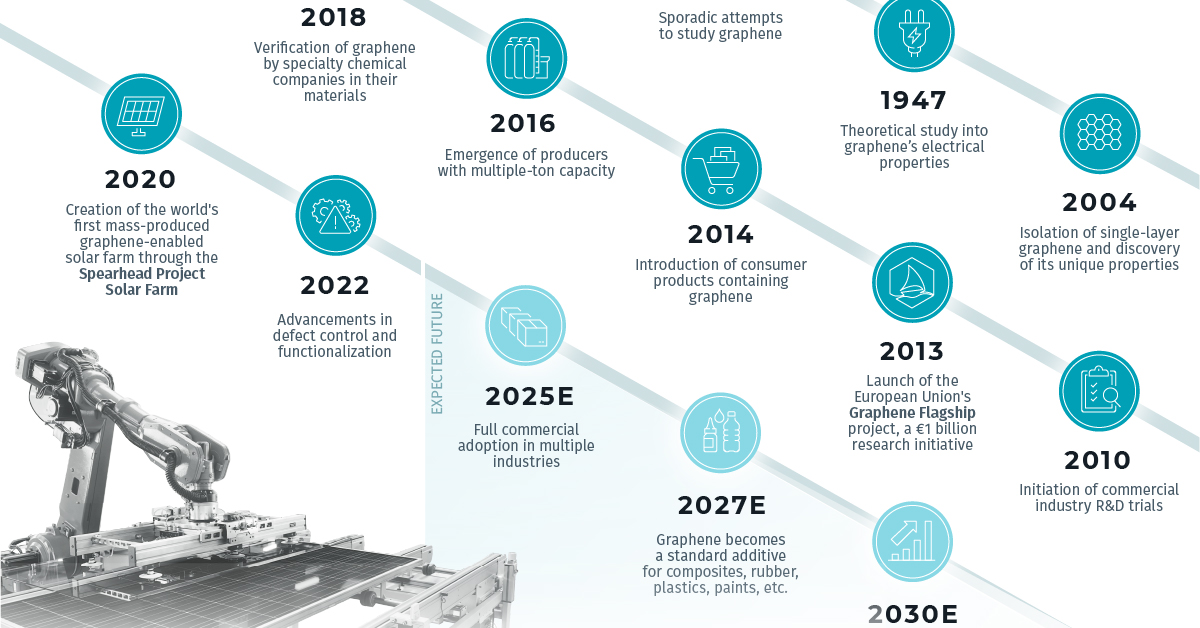Graphene’s Market Ascension in 3 Visuals
Graphene’s Market Ascension in 3 Visuals
Did you know that a two-dimensional single sheet of graphene can support the weight of an elephant?
This wonder material has captivated researchers, industries, and innovators alike, propelling it from a laboratory marvel to a game-changing force for technology and manufacturing.
Sponsored by HydroGraph, this infographic provides an in-depth exploration of graphene’s standout attributes, its diverse range of types and applications, along with the material’s promising commercial trajectory.
Best-Selling Features of Graphene
Industry stakeholders highly value this 2D material’s unparalleled properties.
The Graphene Council conducted a survey asking respondents how important each of the following properties is to them. This is how they responded, with numbers rounded to the nearest five percent:
| Property | Essential | Important | Interesting | Not needed |
|---|---|---|---|---|
| Electrical conductivity | 50% | 25% | 15% | 10% |
| Thermal conductivity | 30% | 35% | 25% | 10% |
| Electrical charge storage | 30% | 20% | 30% | 20% |
| Impact resistance (toughness) | 30% | 35% | 20% | 15% |
| Tensile strength | 30% | 35% | 20% | 15% |
| Corrosion resistance | 30% | 30% | 25% | 15% |
| Electrical charge storage | 30% | 20% | 30% | 20% |
| Barrier properties | 25% | 30% | 30% | 15% |
| Flex Modulus | 20% | 40% | 25% | 15% |
| UV protection | 20% | 25% | 30% | 25% |
| Flame retardation | 20% | 25% | 30% | 25% |
These exceptional properties provide the material with a competitive edge and contribute to its meteoric rise in demand.
Most In-Demand Types of Graphene
Different products require different forms of graphene beyond just its single-layer sheet structure.
- Graphene oxide: A form of graphene modified with oxygen to enhance its dispersibility and mixability. This type of graphene is used in things like conductive inks and drug delivery.
- Graphene nanoplatelets: Theses are structures composed of multiple layers of two-dimensional graphene sheets stacked together, and are commonly used in structural materials and sound transducers.
- Mono & bilayer graphene: These comprise of one or two layers of 2D graphene sheets and can be beneficial for flexible display screens, energy storage devices, and water filtration systems.
Other types include nanoribbons (nano-sized strips), quantum dots (fragments with quantum effects), and nanotubes (rolled-up sheets).
Graphene oxide is expected to have the highest commercial demand by 2030. Here are the market shares of each major type, according to Global Market Insights.
| Type of graphene | Market share, 2030F (%) |
|---|---|
| Graphene Oxide | 44.3% |
| Graphene Nanoplatelets | 32.7% |
| Mono and Bilayer Graphene | 14.5% |
| Others | 8.5% |
| Numbers are rounded |
These future demand projections help serve as a compass for potential investors.
Towards Commercialization
Graphene’s path from discovery to commercialization brims with innovation, and further progress lies on the horizon. Here is a timeline to reflect that.
| Year | Milestone |
|---|---|
| 1859 | Sporadic attempts to study graphene |
| 1947 | Theoretical study into graphene’s electrical properties |
| 2004 | Isolation of single-layer graphene and discovery of its unique properties |
| 2010 | Initiation of commercial industry R&D trials |
| 2013 | Launch of the European Union's Graphene Flagship project, a €1 billion research initiative |
| 2014 | The appearance of consumer products containing graphene |
| 2016 | The emergence of producers with multiple-ton capacity |
| 2018 | Verification of graphene by specialty chemical companies in their materials |
| 2019 | Incorporation of graphene-enhanced materials by Ford Motor Company in vehicles |
| 2020 | Creation of the world's first mass-produced graphene-enabled solar farm through the Spearhead Project Solar Farm |
| 2022 | Advancements in defect control and functionalization |
| 2025 (expected) | Full commercial adoption in multiple industries |
| 2027 (expected) | Graphene becomes a standard additive for composites, rubber, plastics, paints, etc. |
| 2030 (expected) | Graphene disrupts and replaces legacy materials |
Balancing the demand and supply curves is crucial to prevent shortages by 2033, according to Research and Markets. To even out demand and supply, more production capacity for graphene is needed, which will pave the way for future companies and investors in the space.
HydroGraph stands out with its patented eco-friendly technology, positioned to produce more than 10 tons of ultra-pure (99.8%) graphene within a mere three months.

Interested in learning more? Explore investment opportunities with HydroGraph now.

-

 Technology1 day ago
Technology1 day agoAll of the Grants Given by the U.S. CHIPS Act
Intel, TSMC, and more have received billions in subsidies from the U.S. CHIPS Act in 2024.
-

 Technology3 days ago
Technology3 days agoVisualizing AI Patents by Country
See which countries have been granted the most AI patents each year, from 2012 to 2022.
-

 Brands5 days ago
Brands5 days agoHow Tech Logos Have Evolved Over Time
From complete overhauls to more subtle tweaks, these tech logos have had quite a journey. Featuring: Google, Apple, and more.
-

 Technology3 weeks ago
Technology3 weeks agoRanked: Semiconductor Companies by Industry Revenue Share
Nvidia is coming for Intel’s crown. Samsung is losing ground. AI is transforming the space. We break down revenue for semiconductor companies.
-

 AI3 weeks ago
AI3 weeks agoThe Stock Performance of U.S. Chipmakers So Far in 2024
The Nvidia rocket ship is refusing to slow down, leading the pack of strong stock performance for most major U.S. chipmakers.
-

 Technology3 weeks ago
Technology3 weeks agoRanked: The Most Popular Smartphone Brands in the U.S.
This graphic breaks down America’s most preferred smartphone brands, according to a December 2023 consumer survey.


